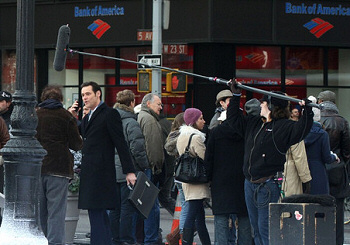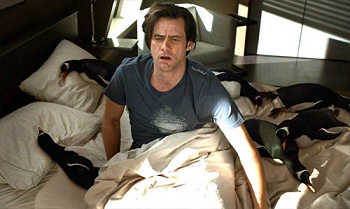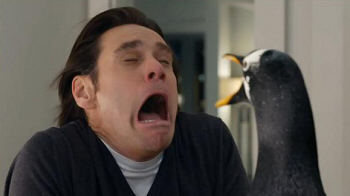NEWS
Mr. Popper's Penguins - About the Production
14 Jun 2011 By Tommy Pihl (JCO Editor-In-Chief)
"Mr. Popper's Penguins" began principal photography on October 7, 2010, and filmed for eleven weeks entirely in New York City, a setting that was central to the filmmakers' vision. While the title character from the Mr. Popper's Penguins book lived in a small town and made a humble living by painting houses, the film's Mr. Popper is a successful real estate developer in a city with some of the most valuable property, and most recognizable architecture, in the world. "The thing that really defined the look of this film was New York City," says Waters. "The fact that we were going to actually make this movie there allowed me to say, okay, we can shoot for a very large scope, and make it feel like a classic New York movie." Adds Jim Carrey: "The film captures New York in a beautiful way. It really makes you feel warm. There's no bad angle; anywhere you put the camera is interesting and has depth, contour and character."

© 20th Century Fox
Waters' behind-the-scenes team included such veterans of New York filmmaking as Oscar®-winning costume designer Ann Roth ("The English Patient"), director of photography Florian Ballhaus ("The Devil Wears Prada," "Red") and Academy Award® nominated production designer Stuart Wurtzel ("Hannah and Her Sisters").
Key locations included such Gotham architectural landmarks as the Flatiron Building on 23rd Street, built in 1902, its shape the function of its triangular plot created by the intersection of and the diagonal line of Broadway and Fifth Avenue. The production filmed exteriors at the Flatiron Building, as well as in an office in the very tip of the "iron." It then moved uptown to film at Frank Lloyd Wright's 1959 Guggenheim Museum on Fifth Avenue and 88th Street. Scenes in which penguins crash a black-tie gala attended by Mr. Popper were filmed on the distinctive spiraling ramp of one of the great modern interiors in the world. Another modern interior in Popper's world is his office, filmed in the new Bank of America building on 42nd Street and Sixth Avenue, which overlooks a magnificent cityscape.
The exterior and lobby of Mr. Popper's building was also filmed on location, on a residential building on prestigious Park Avenue. The interiors of his apartment were created on a stage at Steiner Studios in Brooklyn.

© 20th Century Fox
Popper's desire for a clean, ordered life comes to naught when six wild birds from Antarctica move in with him. He is compelled to accommodate the penguins' need for a cold environment, and opens all of his windows, letting in the frigid New York winter weather. Popper discovers he enjoys acclimatizing his home for the penguins, much to the delight of his kids. "Once the penguins start inhabiting the apartment, it starts taking on a whole life of its own and becomes a kind of winter wonderland," Wurtzel says. Popper turns his vivid imagination into the apartment, adding a mini ice-skating rink and snowman. "It was fun to take something that was so rigid at the beginning and turn it into sort of madness at the end because of the penguins, and the way the whole family sort of took it on and accepted it," Wurtzel adds.
Cinematographer Florian Ballhaus adapted the lighting in the apartment to reflect a new feeling in Popper's home. "Even though it kind of got white and cold, we also started to introduce a warm sunlight into the apartment, so it actually felt like a much more inviting, cozy place," says Waters of Ballhaus' work.
Another important setting in the story of "Mr. Popper's Penguins" is Tavern on the Green, a Victorian stone and brick edifice in Central Park. Built in 1871 as a barn for sheep, Tavern on the Green was converted into a restaurant in 1934, and through the years became a popular dining spot for local glitterati and tourists alike. Closed in 2009, the building now houses a visitors' center. Wurtzel and his team recreated The Tavern's interiors, including its grand dining room. "The Tavern was a wonderful meeting place with a joyful interior and Baroque restaurant, which everybody went to," says Wurtzel. "Every opening-night party, every wrap party, everybody wanted to be at Tavern on the Green."

© 20th Century Fox
Wurtzel recreated the wood-paneled front vestibule of the Tavern, the famous Crystal Room with its ornate chandeliers and flower-filled décor, and approximately twelve feet of Central Park so the views outside the plate-glass windows would look authentic. "It's a sort of emotional composite of how people remember it," he says.
Upon completion of principal photography, the actors - and penguins - returned home or began work on their next projects. But for Waters, Davis, and the post-production teams, months of editing, scoring, visual effects, and mixing lay ahead. Taking a break from putting the final touches on the film, Waters states that "Mr. Popper's Penguins" is for audiences of all ages. "I certainly have been aspiring to make a big comedy that has big emotion," he says. "If we did our work right here, the movie will work on all those levels of entertainment." And Mr. Popper himself - Jim Carrey - offers his hopes for the film: "It puts you in touch with what's important in life, such as the value of love, family and friendship. At the same time, I think audiences will be surprised by how funny and edgy it is. The film has humor that adults will enjoy. It's completely innocent, joyful and uplifting."
» Send to friend
« Newer article | Overview | Older article »









